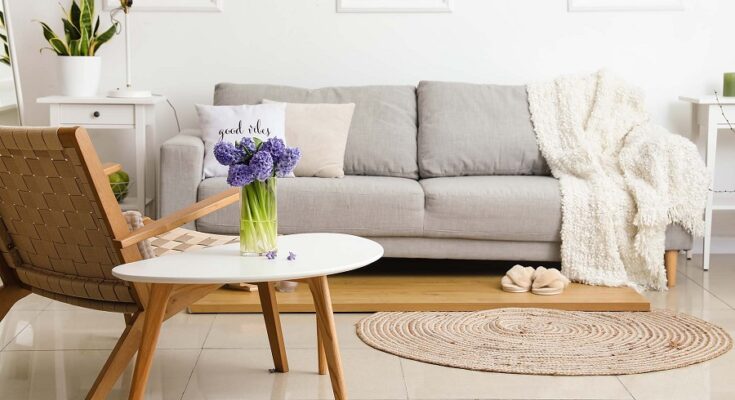Some furnishings carry a quiet influence. You may not describe them first when listing your home’s features, but you feel their presence daily. Rugs soften footsteps and frame your movement. Sofas shape how you rest, speak, or sit still. Office chairs hold your body through hours of work, study or thought. These pieces do not just fill space. They give meaning to it. When chosen with care, they do more than function. They define how your space supports you.
Rugs Framing Movement and Mood
The floor often goes unnoticed, yet it is the first surface you interact with. Rugs help you notice it differently. They add softness, define zones, and reduce harsh echoes. A well-chosen rug can make a hard room feel warm. It can also create a quiet link between furniture, light and layout.
Choosing Texture That Suits the Room
Each room brings a different pace. In busy areas like halls or dining spaces, rugs with tight weaves are easier to clean and wear better with time. Softer textures like wool or high-pile finishes work well in bedrooms or reading corners where movement is less frequent. A rug should feel good underfoot, but it should also serve the room’s rhythm.
For living areas, think about how often people walk through. If it is a space for lounging or lying down, deeper fibers add comfort. If chairs or tables shift around on top, go with a flatter weave that holds its place and stays neat.
Getting the Size Right for Balance
Rug size can change how a room feels. A small rug in a large room creates visual breaks and leaves furniture floating. A large rug that fits under most furniture ties the layout together. Measure the area and give breathing space around the edges. The rug should feel like it belongs to the space, not like it was squeezed into it.
In open-plan rooms, rugs can also help mark where one area ends and another begins. You can use them to shape a dining zone or separate a sitting area from a workspace without building walls or changing flooring.
Letting Pattern and Color Shape the Mood
A rug does not need to lead the visual story. In rooms that already have strong furniture or artwork, keep the rug simple and textural. When the room feels neutral, a patterned rug can introduce movement without overpowering it.
Earth tones bring calm. Blues and greys feel quiet and clean. Bolder shades lift energy but work best when grounded by neutral walls or furniture. Choose based on what the room needs more of—stillness, depth or character.
Sofas Guiding Comfort and Connection
A sofa is more than a seat. It often becomes the heart of a room. You lie back on it. You curl up with a book. You lean against someone you trust. Sofas do not just provide a place to rest. They shape how people gather and what they do once they sit down.
Fitting the Shape to the Purpose
Before picking a fabric or color, think about how the sofa will be used. A long, deep frame works well in a room meant for stretching out and relaxing. A more upright design suits formal sitting or shorter sessions. In tight spaces, consider sofas with slimmer arms or open legs that let light pass through. These details change how full or open the room feels.
Balancing Softness with Support
Comfort feels different to everyone. Some prefer a firmer base that holds shape. Others want something soft that allows the body to sink gently. Pay attention to the seat depth and the height of the backrest. Both affect how well the sofa suits your posture.
If you like to nap on the sofa, choose one that lets you stretch out without twisting. If you entertain guests, go for a layout that allows eye contact and conversation.
Selecting Materials That Live with You
The fabric you choose changes the daily feel of the room. Cotton and linen feel cool and casual. Velvet brings weight and depth. Leather offers clean lines and simple care. Every choice has texture, tone and temperature. Pick one based on who lives in the home and how the space is used.
Office Chairs Supporting Focus and Form
Working at home is not just about the desk. The chair matters just as much. It holds your posture through hours of stillness. It affects your focus and how your body feels once you stand up. The right chair disappears into your routine. It supports without speaking.
Choosing A Structure That Matches the Body
The best chair feels like it adjusts to you. The seat stays level. The backrest supports your spine. Armrests hold your elbows in line with your shoulders. You should feel upright without tension. A proper chair helps you stay present without needing constant readjustment.
A chair should move with you. Swivel bases and tilt functions allow micro-adjustments throughout the day. These small shifts prevent stiffness and help the body stay relaxed during long sessions.
Setting It in a Space That Works
The chair does not work alone. It must sit under a desk at the right height. Your feet should touch the floor. Your knees should stay level with your hips. If the seat is too high or too low, it breaks the flow of work.
Using Materials That Handle Repetition
A chair used daily must last through repeated use. Breathable fabrics help with heat and airflow. Cushions should hold shape and avoid sinking. Wheels should roll smoothly across your floor type. A weak base or noisy joints break focus and shorten the chair’s useful life.
Living with Pieces That Support Daily Life
A home feels whole when its spaces respond to you. Rugs soften the room and give movement a direction. Sofas create places to rest, gather and pause. Office chairs carry you through effort without strain. These pieces do not ask for praise, but you miss them the moment they fail.
Comfort begins with clear intention. Choose items that serve the way you live. Let them hold your shape, lift your routine and settle into the background. When furniture fits the flow of your life, your space feels less like a setup and more like home.




